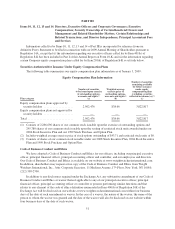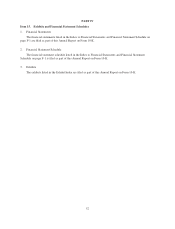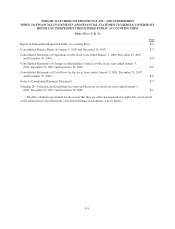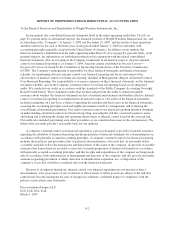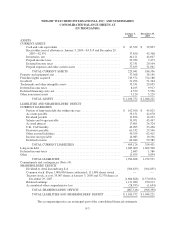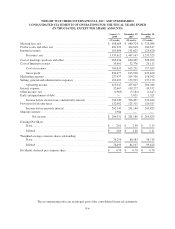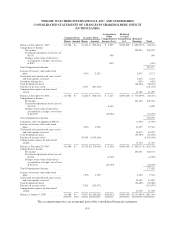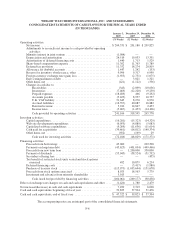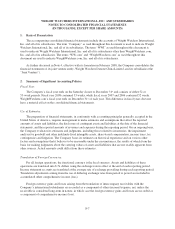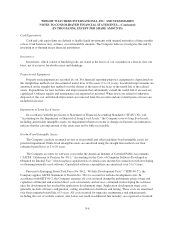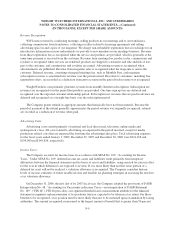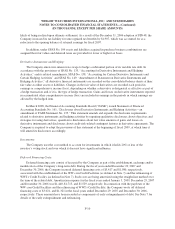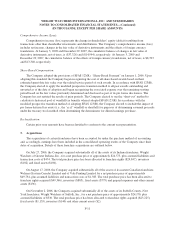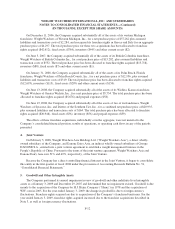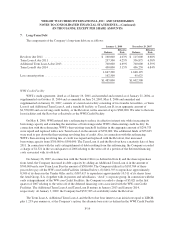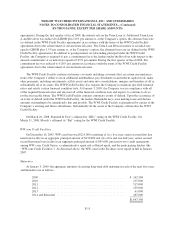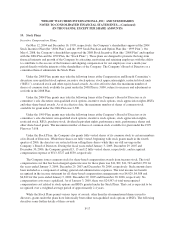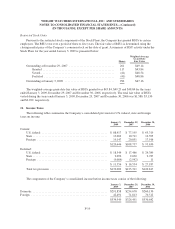WeightWatchers 2008 Annual Report Download - page 74
Download and view the complete annual report
Please find page 74 of the 2008 WeightWatchers annual report below. You can navigate through the pages in the report by either clicking on the pages listed below, or by using the keyword search tool below to find specific information within the annual report.WEIGHT WATCHERS INTERNATIONAL, INC. AND SUBSIDIARIES
NOTES TO CONSOLIDATED FINANCIAL STATEMENTS—(Continued)
(IN THOUSANDS, EXCEPT PER SHARE AMOUNTS)
Revenue Recognition:
WWI earns revenue by conducting meetings, selling products in our meetings and to our franchisees,
collecting commissions from franchisees, collecting royalties related to licensing agreements and selling
advertising space in and copies of our magazine. We charge non-refundable registration fees in exchange for an
introductory information session and materials we provide to new members in our meetings business. Revenue
from these registration fees is recognized when the service and products are provided, which is generally at the
same time payment is received from the customer. Revenue from meeting fees, product sales, commissions and
royalties is recognized when services are rendered, products are shipped to customers and title and risk of loss
pass to the customer, and commissions and royalties are earned. Advertising revenue is recognized when
advertisements are published. Revenue from magazine sales is recognized when the magazine is sent to the
customer. Deferred revenue, consisting of prepaid meeting fees, such as Monthly Pass, and magazine
subscription revenue, is amortized into revenue over the period earned. Discounts to customers, including free
registration offers, are recorded as a deduction from gross revenue in the period such revenue was recognized.
WeightWatchers.com primarily generates revenue from monthly Internet subscriptions. Subscription fee
revenues are recognized over the period that products are provided. One time sign up fees are deferred and
recognized over the expected customer relationship period. Subscription fee revenues that are paid in advance are
deferred and recognized on a straight-line basis over the subscription period.
The Company grants refunds in aggregate amounts that historically have not been material. Because the
period of payment of the refund generally approximates the period revenue was originally recognized, refunds
are recorded as a reduction of revenue when paid.
Advertising Costs:
Advertising costs consist primarily of national and local direct mail, television, online media and
spokesperson’s fees. All costs related to advertising are expensed in the period incurred, except for media
production related costs that are expensed the first time the advertising takes place. Total advertising expenses
for the fiscal years ended January 3, 2009, December 29, 2007 and December 30, 2006 were $214,218 and
$194,960 and $149,856, respectively.
Income Taxes:
The Company accounts for income taxes in accordance with SFAS No. 109, “Accounting for Income
Taxes.” Under SFAS No. 109, deferred income tax assets and liabilities result primarily from temporary
differences between the financial statement and tax bases of assets and liabilities, using enacted tax rates in effect
for the year in which differences are expected to reverse. If it is more likely than not that some portion of a
deferred tax asset will not be realized, a valuation allowance is recognized. The Company considers historic
levels of income, estimates of future taxable income and feasible tax planning strategies in assessing the need for
a tax valuation allowance.
On December 31, 2006, the first day of its 2007 fiscal year, the Company adopted the provisions of FASB
Interpretation No. 48, “Accounting for Uncertainty in Income Taxes—an interpretation of FASB Statement
No. 109” (“FIN 48”). FIN 48 prescribes a recognition threshold and a measurement attribute for the financial
statement recognition and measurement of tax positions taken or expected to be taken in a tax return. For those
benefits to be recognized, a tax position must be more likely than not to be sustained upon examination by taxing
authorities. The amount recognized is measured as the largest amount of benefit that is greater than 50 percent
F-9


